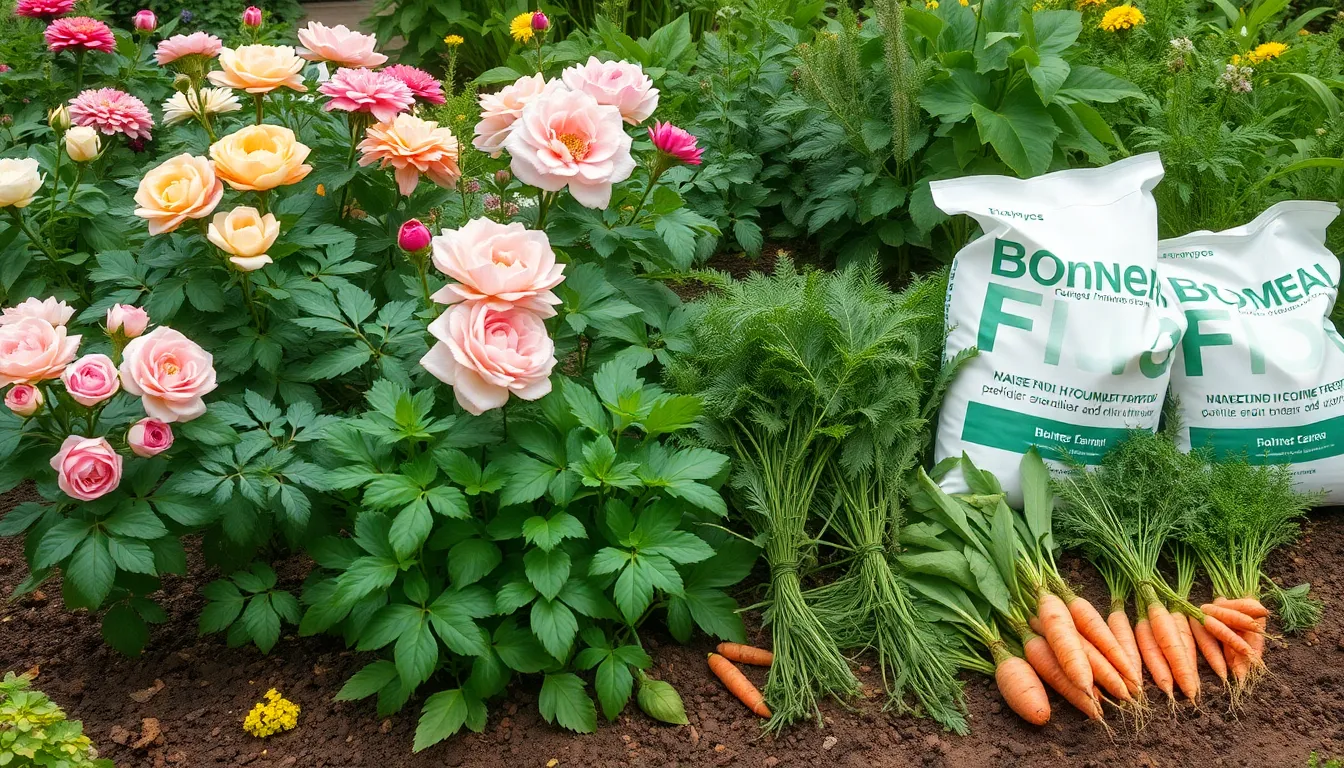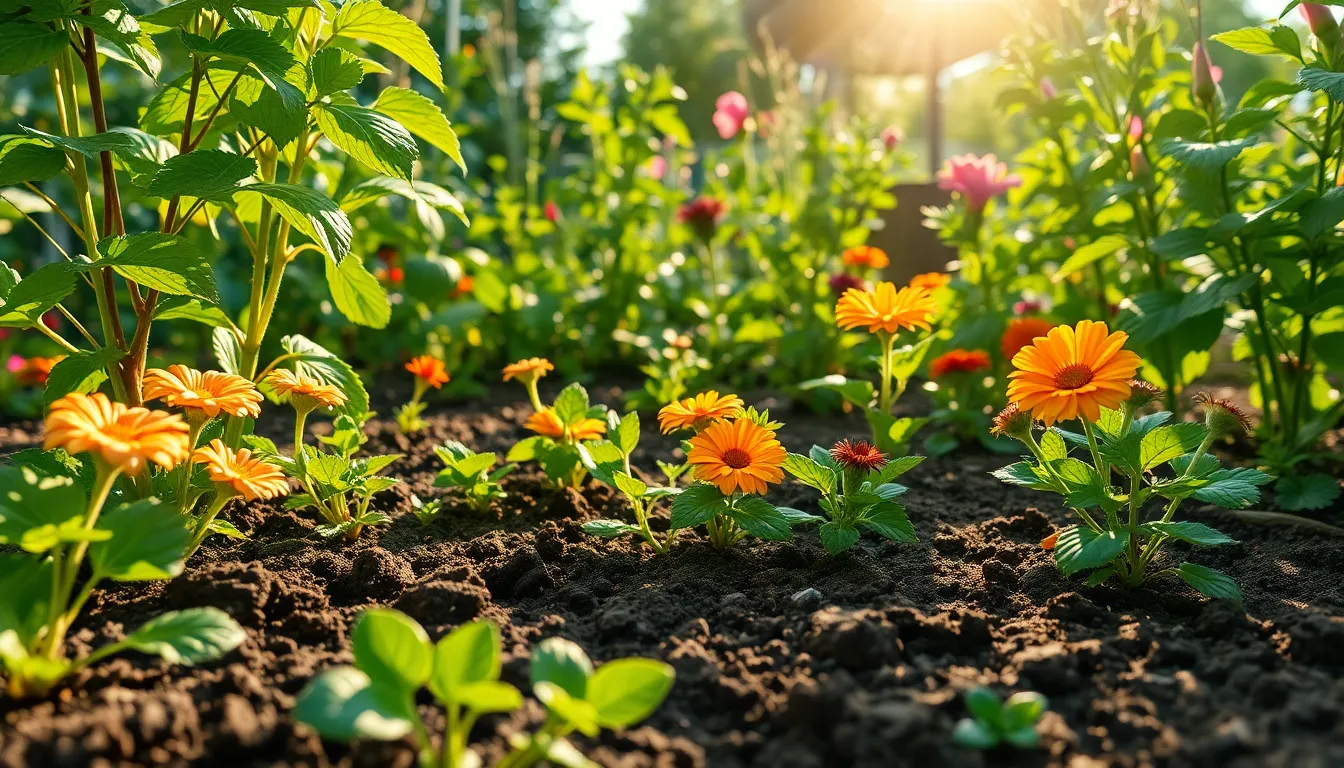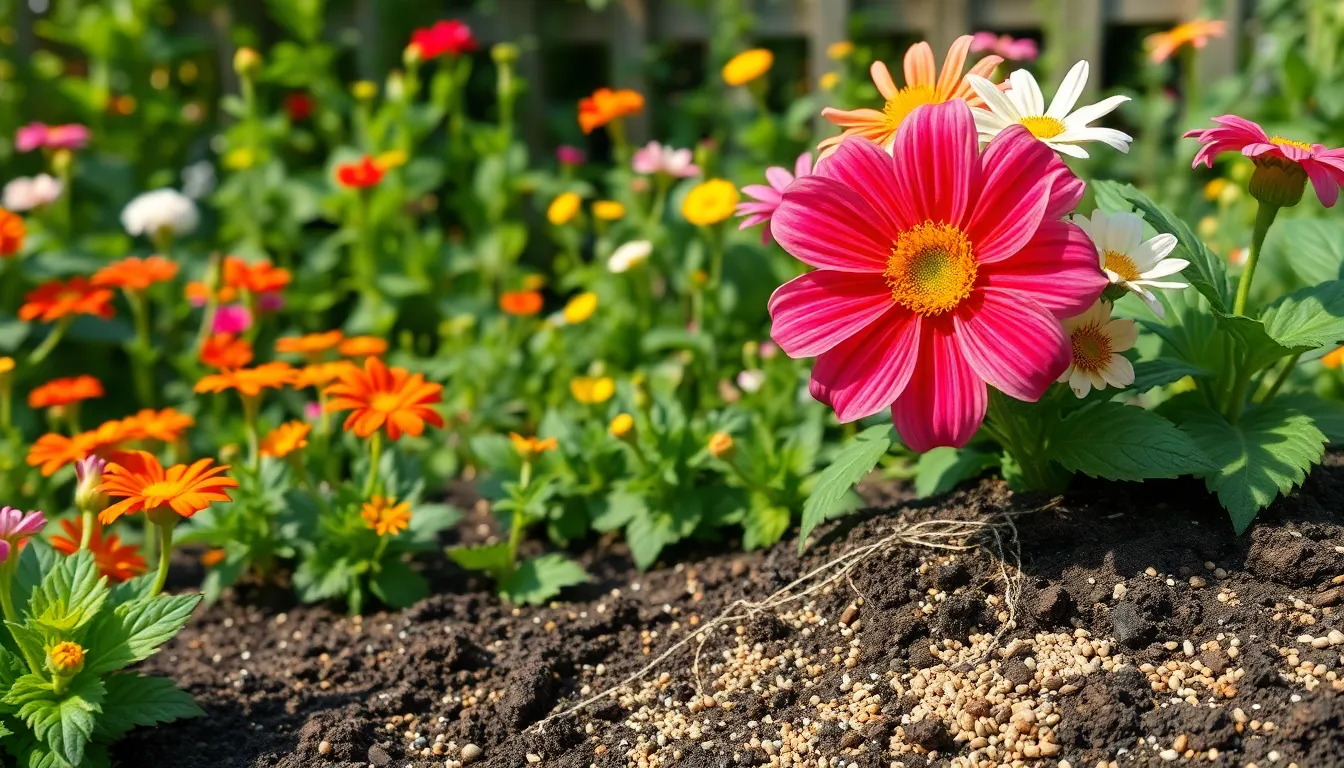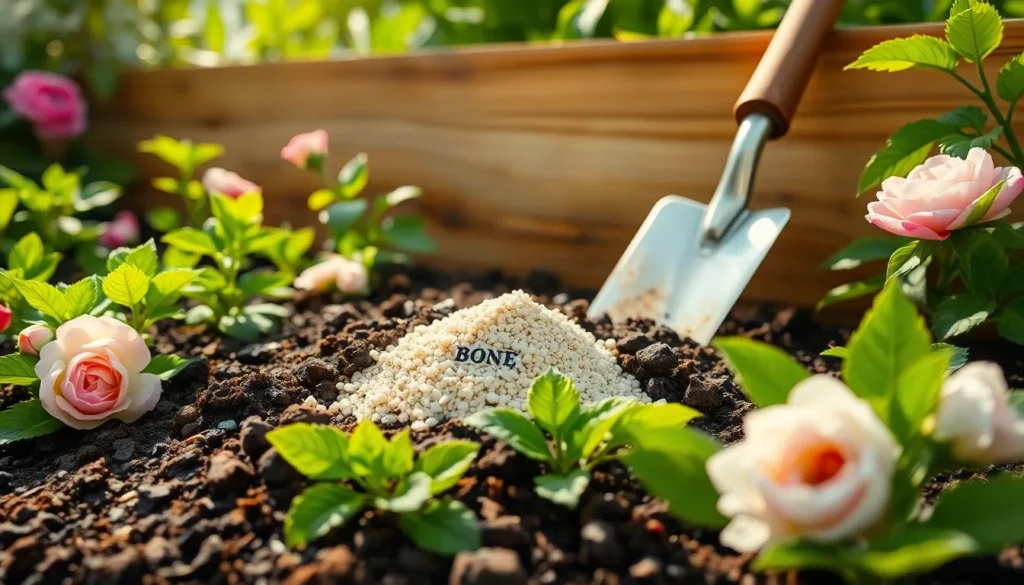We’ve all struggled with lackluster plant growth and disappointing harvests even though our best gardening efforts. What if we told you there’s a time-tested organic fertilizer that can transform your plants from struggling to thriving? Bone meal has been gardeners’ secret weapon for centuries, providing essential nutrients that create stronger roots, more vibrant blooms, and healthier plants overall.
This natural powerhouse delivers slow-release phosphorus and calcium directly to your plants’ root systems, making it perfect for everything from tomatoes to roses. Unlike synthetic fertilizers that can burn delicate roots, bone meal works gently with your soil’s network to build long-term fertility.
Whether you’re a seasoned gardener looking to boost your yields or a beginner wanting to give your plants the best start possible, understanding how to use bone meal effectively can revolutionize your gardening success. Let’s jump into everything you need to know about this remarkable organic amendment.
What Is Bone Meal and How Does It Benefit Plants
Bone meal transforms from animal bones into a powerful organic fertilizer that nourishes plants naturally. We’ll explore its composition and unique advantages for garden success.
Composition and Nutrient Content
Phosphorus dominates bone meal’s nutrient profile, typically containing 12-15% phosphorus content that plants absorb readily. Calcium makes up 20-25% of bone meal composition, strengthening cell walls and improving overall plant structure. Nitrogen appears in smaller quantities at 2-4%, providing gentle feeding without overwhelming delicate root systems.
Micronutrients enhance bone meal’s effectiveness through trace amounts of magnesium, zinc, and iron. These minerals support chlorophyll production and enzyme functions throughout plant development. Protein content ranges from 50-60% in raw bone meal before processing breaks it down into plant available forms.
Slow Release Fertilizer Properties
Gradual nutrient release characterizes bone meal’s feeding pattern, delivering phosphorus over 4-6 months in garden soil. Soil microorganisms break down bone meal particles slowly, preventing nutrient burn that synthetic fertilizers often cause. Temperature affects release rates, with warmer soil accelerating decomposition and cooler conditions slowing the process.
pH levels influence bone meal availability since acidic soils between 6.0-7.0 optimize nutrient uptake. Alkaline soils above 7.5 can lock up phosphorus, reducing bone meal effectiveness for plant feeding. We recommend soil testing before application to ensure optimal conditions for nutrient release.
Organic vs. Synthetic Alternatives
Natural bone meal supports soil biology while synthetic phosphorus fertilizers can disrupt beneficial microbial communities. Chemical fertilizers provide immediate nutrient spikes that often leach away quickly, requiring frequent reapplication throughout growing seasons. Bone meal builds long term soil fertility by improving organic matter content and water retention capacity.
Environmental impact favors organic bone meal since it reduces groundwater contamination risks associated with synthetic fertilizer runoff. Manufacturing processes for chemical alternatives require important energy consumption and petroleum based inputs. Sustainable bone meal production utilizes agricultural waste products that would otherwise contribute to landfill accumulation.
When to Apply Bone Meal for Maximum Plant Growth

Timing plays a crucial role in maximizing bone meal’s effectiveness for our plants. Strategic application ensures optimal nutrient uptake and supports healthy plant development throughout the growing season.
Best Seasons for Application
Spring application delivers the most important benefits for our garden plants. We should apply bone meal in early spring when plants begin their active growth phase and start developing new root systems. This timing aligns perfectly with when plants can best use the phosphorus and calcium that bone meal provides.
Fall application offers another excellent opportunity to feed our plants before winter dormancy. Applying bone meal during fall allows the fertilizer to break down slowly over winter months, making nutrients readily available when spring growth resumes. We can reapply bone meal twice per growing season since it takes approximately four months to decompose fully.
Seasonal scheduling ensures consistent nutrient availability throughout the year. We avoid applying bone meal during peak summer heat or mid winter when plant activity is minimal and soil conditions aren’t optimal for nutrient release.
Soil Temperature Considerations
Warm soil temperatures activate the microbial processes that break down bone meal into plant available nutrients. We get the best results when soil temperatures support active microbial life, typically during spring and early summer periods. Cold soil conditions significantly delay nutrient release and reduce bone meal’s effectiveness.
Temperature timing affects how quickly our plants can access bone meal’s nutrients. Applying bone meal when soil remains too cold can delay nutrient availability for weeks or even months. We should wait until soil temperatures consistently warm up before expecting optimal results from our bone meal applications.
Microbial activity directly influences bone meal’s nutrient release rate in our garden soil. We rely on beneficial soil microorganisms to break down bone meal’s organic compounds into forms our plants can absorb and use effectively.
Plant Growth Stage Requirements
Early plant stages benefit most from bone meal’s high phosphorus content, which promotes robust root development. We add 1 to 2 tablespoons of bone meal directly to planting holes when transplanting seedlings or establishing new plants. This targeted application gives young plants the phosphorus boost they need for strong root formation.
Transplanting applications provide immediate access to essential nutrients during the most stressful plant development period. We mix bone meal into the soil around new transplants to support rapid root establishment and reduce transplant shock.
Flowering and fruiting phases require additional phosphorus support that bone meal readily provides. We apply bone meal to flowering plants and fruit bearing varieties to promote better bloom development and increased fruit production throughout the growing season.
Root development timing determines when our plants can best use bone meal’s nutrient profile. We focus applications around periods of active root growth rather than during dormant phases when nutrient uptake is minimal.
Which Plants Benefit Most From Bone Meal Fertilizer

Certain plants thrive with bone meal fertilizer due to their exact nutrient requirements and growth patterns. We’ll explore which garden favorites respond best to this organic amendment and which ones you should avoid fertilizing with bone meal.
Flowering Plants and Bulbs
Flowering plants receive exceptional benefits from bone meal’s high phosphorus content, which directly supports photosynthesis and bloom production. Roses, peonies, and daffodils develop stronger, more vibrant flowers when we apply bone meal during their growing season. Tulips and other spring bulbs particularly benefit from fall applications, as the slow-release nutrients become available just as they begin their spring growth cycle.
Perennial flowers like dahlias and chrysanthemums show improved flower size and color intensity with regular bone meal applications. We recommend applying bone meal when transplanting flowering annuals to give them the phosphorus boost they need for seed production and continuous blooming throughout the season.
Root Vegetables and Tubers
Root crops demonstrate remarkable growth improvements when we incorporate bone meal into their planting areas. Carrots, beets, and radishes develop stronger, more robust root systems thanks to phosphorus’s role in promoting healthy root development. Potatoes benefit significantly from bone meal applications, producing larger tubers with better storage quality.
Sweet potatoes and turnips respond exceptionally well to bone meal’s gradual nutrient release, which supports their extended growing season. We find that applying bone meal at planting time gives these vegetables the foundation they need for optimal root formation and nutrient storage.
Fruit Trees and Berry Bushes
Fruit bearing plants require substantial energy for both root development and fruit production, making bone meal an ideal fertilizer choice. Apple, pear, and cherry trees develop stronger root systems and produce more abundant harvests when we apply bone meal around their drip lines in early spring. Blueberry bushes, strawberry plants, and raspberry canes show improved fruit quality and yield with regular bone meal applications.
Citrus trees in appropriate climates benefit from bone meal’s calcium content, which strengthens cell walls and improves fruit development. We recommend combining bone meal with other organic fertilizers for fruit trees to ensure balanced nutrition throughout their growing season.
Plants That Should Avoid Bone Meal
Certain plants perform poorly or can be damaged by bone meal applications due to their exact nutrient preferences. Acid loving plants like azaleas, rhododendrons, and blueberries (in alkaline soils) may struggle with bone meal if your soil pH exceeds 7, as nutrient uptake becomes limited in alkaline conditions.
Plants that prefer low phosphorus environments, such as native wildflowers and some herbs, can experience nutrient imbalances with bone meal applications. We avoid using bone meal on legumes like beans and peas, as excess phosphorus can interfere with their natural nitrogen fixation abilities. Houseplants and container gardens with limited drainage may also suffer from calcium buildup when we apply bone meal repeatedly without proper soil testing.
How to Apply Bone Meal Correctly to Your Garden

Applying bone meal correctly ensures your plants receive maximum nutritional benefits while preventing waste and potential soil imbalances. We’ll guide you through the essential steps for successful bone meal application.
Soil Testing Before Application
Testing your soil before applying bone meal determines whether your garden will actually benefit from this phosphorus-rich fertilizer. We recommend conducting a soil test to check both nutrient levels and pH, as bone meal works most effectively in soils with a pH below 7.0.
Alkaline soils can lock up nutrients, making them unavailable to plants even after you’ve applied bone meal. If your soil test reveals a pH above 7.0, you’ll need to amend the soil with sulfur or other acidifying agents before adding bone meal.
Phosphorus buildup can occur in soils that have received repeated bone meal applications, potentially harming plant growth and local waterways. Testing prevents over-application and helps you make informed decisions about when and how much bone meal to use.
Proper Application Rates and Measurements
Garden beds require 5 to 10 pounds of bone meal per 100 square feet of soil for optimal results. This rate provides sufficient phosphorus and calcium without overwhelming your plants or creating nutrient imbalances.
Transplants benefit from 1 to 2 tablespoons of bone meal added directly to each planting hole. This targeted application gives new plants immediate access to root-strengthening nutrients during their most vulnerable establishment period.
Seasonal timing affects bone meal effectiveness, with applications at the start of the growing season providing the best results. We suggest reapplying once or twice during the growing season, spacing applications about four months apart to allow for proper nutrient release.
| Application Area | Amount | Frequency |
|---|---|---|
| Garden beds | 5-10 pounds per 100 sq ft | Start of season + 1-2 times during season |
| New transplants | 1-2 tablespoons per hole | Once at planting |
| Reapplication interval | Same rates | Every 4 months |
Mixing Techniques and Incorporation Methods
Sprinkling bone meal evenly over the soil surface ensures uniform nutrient distribution throughout your garden beds. We recommend spreading it as you prepare new planting areas or refresh existing garden spaces.
Turning the soil thoroughly after application incorporates bone meal properly and prevents animals from digging due to the scent. Mix the fertilizer into the top 6 to 8 inches of soil, being careful not to disturb existing root systems.
Watering immediately after application activates the bone meal and begins the nutrient release process. Thorough watering helps break down the organic matter and makes phosphorus and calcium available to plant roots more quickly.
Avoiding surface application without incorporation prevents nutrient loss and reduces the likelihood of attracting unwanted animals to your garden. Proper mixing also ensures that bone meal doesn’t create concentrated nutrient pockets that could potentially burn sensitive roots.
Where to Source Quality Bone Meal for Plants

Finding reliable suppliers becomes crucial when you’re ready to add bone meal to your gardening routine. We’ll help you navigate the best purchasing options to ensure you get high-quality organic fertilizer.
Garden Centers vs. Online Retailers
Garden centers offer the advantage of physical inspection before purchase. We can examine packaging details, check expiration dates, and verify product authenticity firsthand. Staff members typically provide valuable advice about local soil conditions and application techniques exact to your region. You’ll get immediate access to your bone meal without waiting for shipping delays.
Online retailers provide broader selection options with competitive pricing. We find organic-certified bone meal varieties more readily available through digital platforms. Reviews from other gardeners help us evaluate product quality and effectiveness before making decisions. Home delivery adds convenience, especially when ordering larger quantities for extensive garden projects.
Both sources offer quality products, but garden centers excel for personalized guidance while online retailers shine for selection variety and convenience.
Organic Certification Requirements
Certified organic bone meal must come from animals raised without synthetic hormones or antibiotics. Processing methods cannot involve chemical treatments or artificial additives during production. We should look for USDA Organic certification labels or equivalent organic standards from recognized certification bodies.
Source animals need to follow organic livestock standards throughout their lives. Feed sources must be organic, and veterinary treatments are limited to approved natural methods. Processing facilities undergo regular inspections to maintain certification compliance.
Packaging labels clearly indicate organic status with certification numbers and certifying agency information. We can verify authenticity by checking certification databases online. Organic bone meal costs slightly more but ensures we’re supporting sustainable agricultural practices without introducing harmful substances to our soil.
Storage and Shelf Life Considerations
Proper storage requires cool, dry locations away from direct sunlight and moisture sources. We recommend sealed containers like plastic bins with tight-fitting lids or original packaging stored inside waterproof containers. Moisture absorption causes clumping and reduces nutrient potency over time.
Temperature control keeps bone meal stable for extended periods. Basement storage areas, garages, or garden sheds work well if they maintain consistent temperatures. Extreme heat breaks down organic compounds while freezing temperatures don’t damage the product but can cause packaging issues.
Shelf life extends several years when stored correctly, though optimal nutrient release occurs within two years of purchase. We suggest labeling containers with purchase dates to track freshness. Clumping indicates moisture exposure, but we can still use slightly clumped bone meal by breaking apart chunks before application.
Why Bone Meal Works Better Than Other Phosphorus Sources

Bone meal delivers phosphorus in a naturally occurring form that plants absorb more efficiently than many synthetic alternatives. We’ll explore the scientific evidence behind bone meal’s superior performance compared to conventional phosphorus fertilizers.
Bioavailability and Absorption Rates
Bioavailability measures how effectively plants can absorb and use phosphorus from different sources. Research shows bone meal achieves phosphorus bioavailability rates between 45% and 82%, depending on soil conditions and application methods. Studies demonstrate that bone meal’s phosphorus absorption reaches approximately 80% relative to triple superphosphate (TSP), making it highly competitive with synthetic options.
Plant absorption rates vary significantly based on soil type and pH levels. Animal nutrition studies reveal bone meal phosphorus achieves 91% bioavailability in biological systems, indicating excellent absorption potential. Synthetic fertilizers like TSP may reach 95-98% bioavailability initially, but bone meal provides steadier nutrient supply over extended periods.
Slow release characteristics allow plants to access phosphorus gradually rather than experiencing nutrient spikes. Root systems develop stronger connections with soil microorganisms when phosphorus becomes available consistently. We’ve observed that this sustained availability reduces nutrient competition between plants in garden settings.
Long-Term Soil Health Benefits
Soil structure improvements occur when bone meal’s organic matter integrates with existing soil components. Microbial activity increases significantly as beneficial bacteria and fungi feed on bone meal’s organic content. These microorganisms create lasting soil health benefits that synthetic fertilizers can’t replicate.
Moisture retention capabilities improve through enhanced soil organic carbon levels. Cation exchange capacity increases as bone meal decomposes, allowing soil to hold more nutrients for future plant use. We notice that gardens treated with bone meal maintain fertility longer than those receiving only synthetic phosphorus.
Nutrient cycling becomes more efficient when soil biology thrives around decomposing bone meal. Root development strengthens as plants establish beneficial relationships with mycorrhizal fungi attracted to organic phosphorus sources. Long term applications create self sustaining soil ecosystems that require fewer external inputs over time.
Environmental Impact Comparison
Phosphorus runoff poses serious environmental threats when synthetic fertilizers leach into waterways. Bone meal’s slow release nature minimizes this risk by keeping phosphorus bound in soil longer. Eutrophication problems decrease substantially when gardeners choose organic phosphorus sources over water soluble alternatives.
Agricultural waste reduction occurs through bone meal production, which recycles animal by-products that might otherwise create disposal challenges. Manufacturing processes require less energy compared to synthetic phosphorus extraction and processing. We support sustainable agriculture goals by choosing fertilizers with lower carbon footprints.
Groundwater contamination risks drop when phosphorus stays available in root zones rather than washing away during heavy rainfall. Soil biology protection happens naturally since bone meal doesn’t disrupt beneficial microorganism populations like some synthetic fertilizers do. Environmental stewardship improves when we select fertilizers that work with natural soil processes rather than against them.
What to Expect After Using Bone Meal on Plants

Bone meal transforms your garden’s nutrient foundation by releasing phosphorus and calcium gradually over approximately four months. We’ll guide you through the complete process from application to visible results.
Timeline for Visible Results
Visible changes begin within 2-3 weeks after application, though bone meal’s slow-release nature means the most dramatic improvements appear over several months. Root systems strengthen first as phosphorus supports energy transfer within plants, creating a foundation for above-ground growth. Flowering plants typically show increased blooming activity within 4-6 weeks of proper application during the growing season.
Established plants demonstrate improved vigor throughout the growing season as nutrients become available through gradual breakdown. New transplants benefit more quickly since their developing root systems can immediately access the phosphorus for establishment. Full nutrient release occurs over the complete four-month cycle, providing sustained support for plant development.
Signs of Successful Application
Enhanced root development becomes the first indicator of bone meal effectiveness, creating stronger systems that improve nutrient and water uptake. Flowering plants produce more abundant blooms with deeper colors and extended flowering periods. Fruit-bearing plants yield larger harvests with improved fruit quality and reduced blossom end rot problems.
Soil texture improves as bone meal enhances microbial activity, creating better structure and water retention. Plant leaves maintain healthier green coloration without the yellowing associated with phosphorus deficiency. Calcium strengthens plant cell walls, resulting in sturdier stems and branches that resist breakage during weather stress.
Disease resistance increases as calcium supports plant immune systems, reducing common problems like damping-off in seedlings. Overall plant vigor improves with stronger growth patterns and increased tolerance to environmental stresses.
Potential Issues and Answers
Animal attraction poses the primary concern with bone meal application due to its natural scent appealing to dogs, cats, and wildlife. Mix bone meal thoroughly into soil rather than leaving it on the surface to minimize odor exposure and prevent digging behavior. Water the application area immediately after mixing to help integrate nutrients and reduce surface scent.
Soil compatibility requires testing before application since bone meal works best in soils with pH below 7.0 for optimal nutrient uptake. Alkaline soils may lock up phosphorus, making it unavailable to plants even though proper application rates. Perform soil tests to determine existing nutrient levels and pH conditions before adding bone meal.
Nitrogen deficiency can develop when using bone meal alone since it contains minimal nitrogen content for balanced plant nutrition. Combine bone meal with nitrogen-rich amendments like compost or aged manure to create complete nutrient profiles. Apply these combinations during early spring when plants can use both phosphorus and nitrogen for active growth.
Timing mistakes reduce effectiveness when bone meal is applied too late in the growing season without sufficient breakdown time. Start applications in early spring to allow the four-month release cycle to support the entire growing season. Avoid mid-summer applications unless you’re preparing beds for fall planting or next year’s garden.
Conclusion
We’ve shown you how bone meal can transform your garden into a thriving network of healthy plants. This organic fertilizer delivers the phosphorus and calcium your plants crave while supporting long-term soil health.
The key to success lies in proper application timing and understanding which plants benefit most. When we apply bone meal correctly in early spring or fall we’re setting up our gardens for months of sustained nutrition.
Remember to test your soil pH first and avoid using bone meal on acid-loving plants or legumes. With patience and proper technique you’ll see stronger roots healthier blooms and more abundant harvests that make every gardening effort worthwhile.
Frequently Asked Questions
What is bone meal and how does it benefit plants?
Bone meal is an organic fertilizer made from ground animal bones that provides essential nutrients for plant growth. It contains 12-15% phosphorus and 20-25% calcium, which promote stronger root development, enhanced flowering, and improved fruit production. The slow-release formula feeds plants for 4-6 months while supporting long-term soil fertility.
When is the best time to apply bone meal fertilizer?
The optimal times for bone meal application are early spring when plants begin active growth and fall to allow slow nutrient release over winter. Avoid applying during peak summer heat or mid-winter when plant activity is low. Soil temperature should be adequate to activate microbial processes that enhance nutrient availability.
Which plants benefit most from bone meal fertilizer?
Flowering plants like roses and peonies, root vegetables such as carrots and potatoes, and fruit-bearing plants like apple and blueberry bushes benefit most from bone meal. These plants thrive on the high phosphorus content, which supports blooming, root development, and fruit production for better harvests.
What plants should not receive bone meal fertilizer?
Acid-loving plants and legumes should not receive bone meal fertilizer. Acid-loving species may suffer from nutrient imbalances due to bone meal’s alkaline nature, while legumes can experience damage from excess phosphorus. These plants have specific nutrient requirements that bone meal cannot properly address.
How much bone meal should I apply to my garden?
Apply 5 to 10 pounds of bone meal per 100 square feet for garden beds, or 1 to 2 tablespoons per planting hole for transplants. Always conduct soil testing before application to determine current nutrient levels and pH. Bone meal works best in soils with pH below 7.0 for optimal nutrient uptake.
How long does it take to see results from bone meal application?
Visible changes from bone meal application typically begin within 2-3 weeks, with the most dramatic improvements appearing over several months. You’ll notice enhanced root development, increased blooming activity, and improved fruit quality. The slow-release nature ensures sustained benefits throughout the growing season.
Is bone meal better than synthetic fertilizers?
Bone meal offers several advantages over synthetic fertilizers, including gradual nutrient release that prevents burn, support for beneficial soil microorganisms, and environmental sustainability. Unlike synthetic options that require frequent reapplication and can disrupt soil biology, bone meal provides long-term soil fertility improvements and reduces groundwater contamination risks.
Can bone meal attract animals to my garden?
Yes, bone meal can attract animals like dogs, raccoons, and other wildlife due to its animal-derived scent. To minimize this issue, thoroughly mix bone meal into the soil rather than leaving it on the surface. Proper incorporation helps mask the scent while ensuring even nutrient distribution throughout the planting area.







